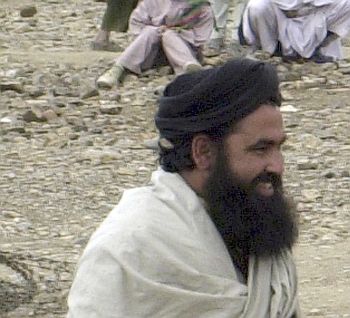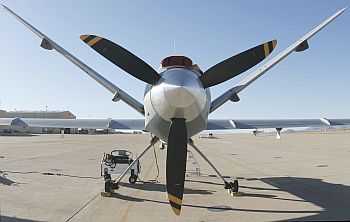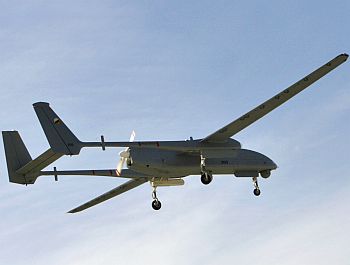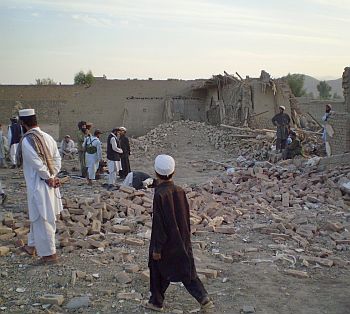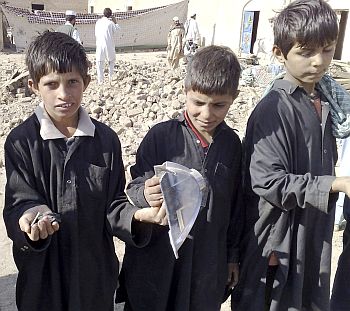 | « Back to article | Print this article |
Death from 30,000 feet above
Ironically, Mehsud is reported to have said about the drone attacks, 'Every time they kill innocent civilians, they are providing me with three to four suicide bombers.'
What are these drones? How do they work? And most importantly, why have they killed only 15 terrorists and as many as 687 civilians?
Brigadier Gurmeet Kanwal (retired), director, Centre for Land Warfare Studies, explains what these agents of destruction that deal death from 30,000 feet above are to rediff.com's Krishnakumar P.
Used for both surveillance and attack
'Drone' is the colloquial term used to refer to Unmanned Aerial Vehicles and Unmanned Combat Aerial Vehicles. In broad terms, a UAV is a surveillance device and a UCAV is one that is fitted with weapons to target suspects from air.
Though drones have been in use since the 1950s, the United States started using them to carry weapons in its war against Afghanistan and Iraq. Earlier, the drones carried cameras or sensors and were able to be air-borne only for short periods, and were prone to a host of technical problems.
"These days, they can fly at high altitudes and can stay in air for longer durations. Some of the advanced drones can fly at heights of 30,000 feet and can stay airborne for up to 40 hours," says Brigadier Kanwal.
In recent years, they have been used for both surveillance and attack.
Predator drones most common
The Predator drones are the ones that are used most in the war against terror by the US. In October 2002, the US admitted for the first time that it was using armed drones to attack Al Qaeda and Taliban targets in Iraq and Afghanistan.
Reaper and Globemaster are other types of drones which are not used as frequently. The Israelis have manufactured a drone called the Heron. Drones cost a few millions dollars excluding the firepower (missiles alone might cost millions of dollars).
Drones can carry only a finite weight
There are many ways in which they can be used.
1. UAV locks target, UCAV fires.
2. UCAV itself performs both operations -- spotting targets and firing.
And these are activated by the following methods:
1. UCAVs fired from a remote location.
2. UCAVs fired by an operator.
"For these operations, you have to use two drones.The surveillance drone will identify the target and lock on to it. The UCAV will then use the coordinates to hone in on the target and fire the missile. There are also cases where the UCAV attack drone itself is fitted with both surveillance equipment and weapons and performs the duties by itself," says Brigadier Kanwal.
However, the drones can carry only a finite weight and this has to be judiciously distributed between surveillance equipment and weapons. "If you are going to cram a drone with cameras and sensors, then there is only so much firepower it can carry," the brigadier adds.
Explaining the ways in which the drones are activated, he says, "They are auto-progammed. They fly in a certain path and are programmed to detect certain heat signatures. Assume they are programmed to hit a battle tank. During the day, they can detect a tank because a tank will be giving out higher heat signals than its surrounding because the metal heats up faster and to higher temperatures. The same tank in the night will be giving out colder signals than its surroundings because its temperature is lower than that of the surroundings."
Most of the time, there is someone who is watching the images captured by the drones and is assessing the available intelligence. "If there is human intelligence available then it increases the chances of hitting the target," he says.
Explaining further, he says: "Say, your spy has told you that a meeting is supposed to happen in one particular village. You send a drone to see what is happening there. You see that many people are going to a particular house. And if you are able to identify some of the faces, then the operator gives the command to fire at that building."
In these type of operations, a lot depends on the quality and skills of the operators, who are generally within 100 km of the targets.
Tracking the target
An article in a Pakistani newspaper said the Taliban had figured out the way in which the drones zero in on their targets. A local commander was quoted as saying: 'These aircraft are guided by SIM cards that are inserted into a cell phone used by the enemies's spies. The SIM card sends a signal to the satellite that guides and tells the drone to shoot the missile.'
Brigadier Kanwal says that communications technology does play a crucial part in surveillance.
"Cell phone surveillance is one way of tracking down enemies. But they would also be smart. They won't use the same SIM card for a long time. But you can identify voice patterns. Voice spectrums are just like fingerprints but only slightly less unique. While there cannot be another person with the same finger print as I do, there are chances that there might be another person who has the same voice spectrum as me, but he might be in Timbuktu. So, determining the enemy's location can be done by tracking cell phone signals."
Drones have killed many civilians
The system of carrying out drone attacks does not seem to be a precise science, but a complex system built of intelligence gathering, assumptions, guesses and the process of elimination to arrive at the enemy's location.
No wonder that the drones have also killed so many civilians.
'Of the 60 cross-border Predator attacks carried out by the Afghanistan-based American drones, only 10 were able to hit their actual targets, killing 14 wanted Al Qaeda leaders besides killing 687 innocent civilians,' a Pakistan newspaper report said.
A lot of things can go wrong. "Mostly there are technical issues. And then there is faulty information," Brigadier Kanwal points out.
What this means is that many people converging at a single house in a village does not necessarily have to be a meeting of terrorists, it can also mean a function or a wedding. And there is no way of ascertaining if the people are guests at a wedding or terrorists plotting their next suicide mission.
"Also, you know how houses in rural areas in the subcontinent are. They are cheek by jowl and when you lock on a house from that distance, there are instances where the neighbour is hit," he said.
A research paper in the Foreign Policy Journal notes, 'Superb intelligence is necessary to reduce casualties. Operators must know not only where the terrorists are, but also who is with them and who might be within the blast radius. This level of surveillance may often be lacking, and terrorists' deliberately use of children and civilians as shields make civilian deaths even more likely.'
'The best worst option'
Because though they are not the best, they still are 'the best worst option', feel some experts. "It is not the most effective option. But among the methods available, it is the one that works, despite the limitations of technology and the errors associated with it," says Brigadier Kanwal.
The fact that they are not manned has a two-pronged benefit. One advantage is that they do not put one more life -- that of a pilot -- at risk.
And it also avoids diplomatic embarrassment. "Imagine the fallout if F-16s are to fly into Pakistani air space and carry out these attacks," the brigadier says.
Along with the mounting civilian casualties, the drone attacks have led to a potent mixture of public anger and distrust against the US among citizens of its key ally, Pakistan. They are also criticised because they give the terrorists another reason to brainwash and recruit more people to fight the West.
Residents of Pakistan's tribal areas, who are hit hardest by the drone attacks, reportedly view the Americans as a bunch of cowards who do not have the courage to come out in the open for a fight.
Foreign Policy Journal adds, 'We must not pretend that the killings are anything but a flawed short term expedient that at best reduces the Al Qaeda threat, but by no means eliminates it.'
Genuine threat to India
In June 2002, Pakistan shot down an Indian UAV that had strayed into its air space. Yes, India has drones too.
But we have only UAVs. There is an urgent need for India to have UCAVs (the ones that can fire weapons)," says Brigadier Kanwal.
"What if a bunch of militants have infiltrated into Indian territory and are sitting on top of an inhospitable peak? Scaling it manually will take 10 hours. But if we have drones, then it is easy to take the targets out," he added.
India also needs to seriously consider this option as Pakistan is applying pressure on the US to give it some drones. The US now only shares information obtained by using drones.
And if and when Pakistan acquires them, there is a genuine threat that some of them will be moved from the country's western border to the eastern border.
"They have used any and every American arm given to them against India," says Brigadier Kanwal. "There is no reason to believe that they won't do it again."
